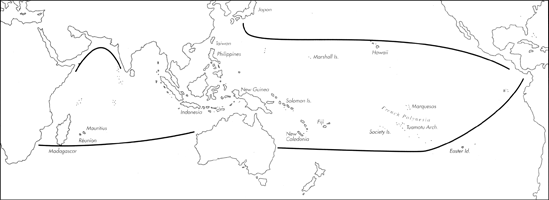
Skip Navigation Links
View access keys for this site.

Range: Indo-Pacific except for the Red Sea and Easter Id.; also W. coast of Central America.
Description: Moderately small to medium-sized, moderately solid to solid. Last whorl usually broadly ventricosely conical; outline convex adapically and straight below. Shoulder angulate to subangulate, strongly to weakly tuberculate. Spire of low to moderate height, outline straight to convex. Larval shell multispiral. Postnuclear spire whorls tuberculate. Teleoconch sutural ramps flat to concave, with 3 increasing to 6-7 spiral grooves. Last whorl with often strong, granulose spiral ribs basally, sometimes to shoulder.
| Shell Morphometry | ||
|---|---|---|
| L | 25-59 mm | |
| RW | 0.20-0.40 g/mm | |
| (L 25-40 mm) | ||
| RD | 0.71-0.87 | |
| PMD | 0.75-0.87 | |
| RSH | 0.07-0.20 | |
Ground colour of last whorl white, suffused with pink mainly in juvenile specimens. Pattern of black axial streaks or flammules usually leaves 2 narrow white bands, at shoulder and near centre. Larval whorls white; apex often suffused with pink. Later sutural ramps white, variously blotched with black. Aperture bluish white behind a brownish black margin.
Periostracum yellow, thin, translucent, and smooth.
Dorsum of foot beige, suffused with pink at its extremities; anterior part with solid red frontal zone followed by a large bilobate black blotch; black dots arrayed into a pre-marginal line along lateral and posterior sides. Sole of foot bordered with a discrete black line about 1 mm from the edge. Tentacles white. Rostrum and siphon white dotted with black or brown, with a solid red tip and a few red dots behind (Pl. 74, Fig. 11) (N. Papua New Guinea: Chaberman, pers. comm., 1981). In Hawaii, animal black, with a broad central longitudinal tan stripe on sole of the foot and rostrum and siphon with red tips (Kohn, 1959a). In Maldives, sole reddish yellow, with distinctly red marginal parts; its black marginal line is not continuous around posterior end (Kohn, unpubl. observ.).
Radular teeth very short, with little or no armature at apex, with a basal spur (James, 1980).
Habitat and Habits: On intertidal benches, less frequently on slightly subtidal reef platforms; often close to the seaward edge of its habitat. C. chaldaeus lives on sand, beachrock, and truncated reef limestone with or without a thin layer of sand or algal turf, in coral rubble with or without sand and on dead coral heads or rocks (Cernohorsky, 1964; Kohn, 1959b/1966/1968; Kohn & Orians, 1962; Kohn & Nybakken, 1975; Leviten & Kohn, 1980; Reichelt & Kohn, 1985; Grosch, pers. comm., 1989).C. chaldaeus is known to feed on errant polychaetes of the families Nereidae and Eunicidae; diet composition varies with habitat. On reef platforms when suitable nereid species become rarer, it may shift to a single eunicid species (Palola siciliensis). In the latter case, it eats worms of the same species as C. ebraeus and C. miles but captures them in a different habitat (Kohn & Orians, 1962; Kohn, 1959b, 1966, 1968; Kohn & Nybakken, 1975; Leviten & Kohn, 1980; Reichelt & Kohn, 1985).
Discussion: Only C. ebraeus closely resembles C. chaldaeus. They overlap broadly in shell morphometry, but C. ebraeus differs distinctly in colour pattern with usually 3-4 spiral rows of black markings on the last whorl and in fewer and weaker spiral grooves on its late sutural ramps. The granulose spiral ribs of the last whorl are stronger and extend over more of the shell in C. chaldaeus. The animals of both species may be very similar (Hawaii) or clearly separable (N. Papua New Guinea). They often occur sympatrically and may share the same habitat, sometimes even the same microhabitat. C. chaldaeus typically is less abundant and occurs closer to the seaward margin of its habitat.

C. chaldaeus Range Map
This section contains verbatim reproductions of the accounts of 316 species of Conus from the Indo-Pacific region, from Manual of the Living Conidae, by Röckel, Korn and Kohn (1995). They are reproduced with the kind permission of the present publisher, Conchbooks.
All plates and figures referred to in the text are also in Röckel, Korn & Kohn, 1995. Manual of the Living Conidae Vol. 1: Indo-Pacific Region.
The range maps have been modified so that each species account has it own map, rather than one map that showed the ranges of several species in the original work. This was necessary because each species account is on a separate page on the website and not confined to the order of accounts in the book.
Return to framed version (returns to search page)